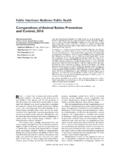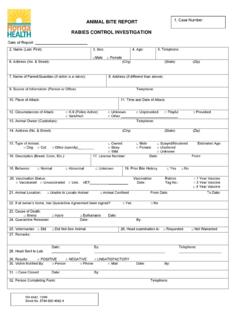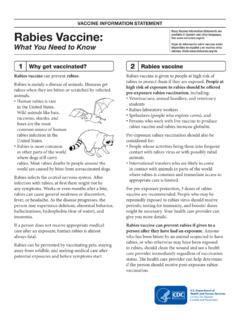Transcription of WHO Guide for Rabies Pre and Post Exposure Prophylaxis in ...
1 WHO Guide for Rabies Pre and Post Exposure Prophylaxis in Humans Updated 2014. Health Statistics and Informatics General considerations in Rabies Post- Exposure Prophylaxis (PEP). WHO strongly recommends discontinuation of the nerve tissue vaccine, and replacement with modern concentrated and purified cell culture derived vaccines (CCDV) and embryonated egg- based Rabies vaccines These vaccines must comply with WHO criteria for potency and innocuity following satisfactory assessment in humans during well-designed field trials Updatedand Health Statistics 2014. Informatics Top 10 General Considerations in Rabies PEP. 1. Wounds must be immediately washed/flushed for 15 minutes and disinfected 2.
2 Rabies PEP should be instituted immediately. PEP consists of a course of potent, effective Rabies vaccine that meets WHO recommendations and administration of Rabies immunoglobulin 3. PEP must be applied using vaccine regimens and administration routes that have been proven to be safe and effective 4. PEP does not have contraindications if purified Rabies immunoglobulin and vaccine are used. Pregnancy and infancy are not contraindications to PEP. Updatedand Health Statistics 2014. Informatics Top 10 General Considerations in Rabies PEP. 5. If Rabies immunoglobulin is not available on first visit, use can be delayed by up to 7 days from the date of the first vaccine dose 6. Initiation of PEP should not await the results of laboratory diagnosis or be delayed by dog observation when Rabies is suspected 7.
3 When suspect rabid animal contacts (excluding bats) occur in areas free of carnivore-mediated Rabies and where there is adequate surveillance in place, PEP may not be required. The decision must be based on expert risk assessment Updatedand Health Statistics 2014. Informatics Top 10 General Considerations in Rabies PEP. 8. Patients presenting for Rabies PEP even months after having been bitten should be treated as if the contact had recently occurred 9. PEP should be administered even if the suspect animal is not available for testing or observation. However, vaccine and immunoglobulin administration may be discontinued if the animal involved: is a vaccinated dog (cat or ferret) that following observation for 10 days, remains healthy or is humanely killed and declared negative for Rabies by a WHO prescribed laboratory test 10.
4 In areas enzootic for (canine and wildlife) Rabies , PEP should be instituted immediately unless adequate laboratory surveillance and data indicates that the species involved is not a vector of Rabies Updatedand Health Statistics 2014. Informatics Rabies Post- Exposure Prophylaxis Modalities Wound treatment: Should be immediate Is essential even if the person presents long after Exposure Consists of: Immediate washing and flushing wound for 15 minutes with soap and water, or water alone Disinfection with detergent, ethanol (700ml/l), iodine (tincture or aqueous solution), or other substances with virucidal activity Bleeding at any wound site indicates potentially severe Exposure and must be infiltrated with either human or equine Rabies immunoglobulin Other treatments include Administration of antibiotics and tetanus Prophylaxis Updatedand Health Statistics 2014.
5 Informatics Rabies Post- Exposure Prophylaxis Modalities In countries or areas enzootic for Rabies , Exposure to suspected or confirmed rabid animals are categorised by WHO as follows: Updatedand Health Statistics 2014. Informatics Administration of Rabies Immunoglobulin (RIG). Administration of Rabies immunoglobulin (RIG) to wounds classified as category III Exposure , is of upmost importance in wound management. Bites to the head, neck, face hand and genitals are category III. exposures Infiltrate RIG into the depth of the wound and around the wound RIG should be infiltrated around the wound as much as anatomically feasible Remaining RIG should be injected at an intramuscular site distant from that of vaccine inoculation ( into the anterior thigh).
6 Updatedand Health Statistics 2014. Informatics Administration of Rabies Immunoglobulin (RIG). Quantities/volume of RIG: 20 IU/ kg for Human RIG (HRIG). or 40 IU/ kg of Equine RIG. (ERIG). Total recommended dose should not be exceeded If RIG is unavailable on first visit, its administration can be delayed by a maximum of 7. days from the date of first vaccine dose If the calculated dose of RIG. is insufficient to infiltrate all wounds, sterile saline may be used to dilute it 2 to 3 fold to permit thorough infiltration Updatedand Health Statistics 2014. Informatics Administration of Rabies Immunoglobulin (RIG). There are no scientific grounds for performing a skin sensitivity test prior to administration of equine Rabies immunoglobulin (ERIG).
7 The treating physician should be prepared to manage anaphylaxis which, however rare, could occur at any stage of the ERIG administration Updatedand Health Statistics 2014. Informatics Rabies Post- Exposure Prophylaxis Modalities Non-specific care Postpone suturing if possible; if suturing is necessary ensure that RIG has been applied locally Apply antimicrobials and tetanus toxoid if necessary Updatedand Health Statistics 2014. Informatics Intramuscular regimens for Rabies Post- Exposure Prophylaxis There are 3 intramuscular schedules for category II and III. exposures: The 5 dose regimen The 2-1-1 regimen The 4 dose regimen with RIG in both categories II and III. Vaccines should be injected into the deltoid muscle for adults and children aged 2 years and more.
8 The anterolateral thigh is recommended for younger children. Vaccines should not be injected into the gluteal region Updatedand Health Statistics 2014. Informatics Intramuscular regimens for Rabies Post- Exposure Prophylaxis The 5 dose intramuscular regime: (1-1-1-1-1). One dose of the vaccine should be administered on days 0, 3, 7, 14 and 28. Given in the deltoid region or, for young children, into the antero-lateral area of the thigh muscle Updatedand Health Statistics 2014. Informatics Intramuscular regimens for Rabies Post- Exposure Prophylaxis The 2-1-1 regimen: (2-0-1-0-1). Two doses are given on day 0 in the deltoid muscle, right and left arm An additional one dose is administered in the deltoid muscle on day 7.
9 And day 21. Updatedand Health Statistics 2014. Informatics Intradermal regimen for Rabies Post- Exposure - Prophylaxis The intradermal (ID) regimen requires a reduced volume of vaccine to be utilised than any of the intramuscular regimens therefore, reducing vaccine cost by 60-80%. This method is appropriate where vaccine or/and money are in short supply, particularly in rural areas with high-flow clinics Updatedand Health Statistics 2014. Informatics Intradermal regimen for Rabies Post- Exposure - Prophylaxis The volume per intradermal (ID) site is mL. Using the ID route of administration, PVRV (Verorab ) and PCECV (Rabipur ) have been proven to be safe and efficacious mL per ID site is used, according to WHO recommended ID regimen Vaccine administered ID must raise a visible and palpable bleb in the skin.
10 In the event that a dose of vaccine is inadvertently given subcutaneously or intramuscularly, a new dose should administered intradermally Updatedand Health Statistics 2014. Informatics Intradermal PEP regimen for Category II and III Exposures The 2-site intradermal method: (2-2-2-0-2). One dose of vaccine, of ml is given intradermally at two different lymphatic drainage sites Usually administered in the deltoid muscle on the left and right upper arm and suprascapular area Given on days 0, 3, 7 and 28. Updatedand Health Statistics 2014. Informatics Adopting the ID route for PEP. Any country willing to adopt the WHO recommended ID. regimen need not repeat immunogenicity studies in their own population WHO recommends use of the WHO prequalified Rabies vaccines that can be used by the ID route.













